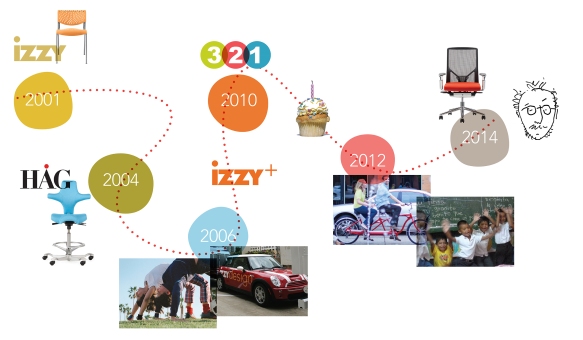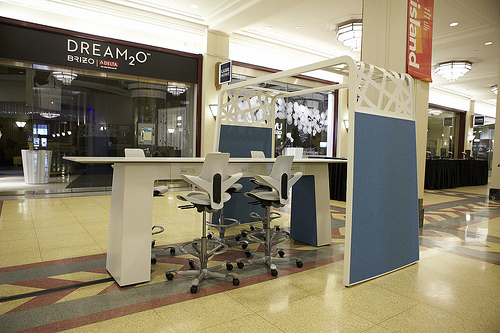“The workplace is no longer about sticking people in a cube, adding some lumbar support, and telling them to not move until lunch.”
The man who spoke those words, our founder Chuck Saylor (pictured above), knows a thing or two about the importance of movement. It was, in part, seeing the effects of stasis in cubicle-bound workplaces that inspired him to move out on his own and start a different kind of furniture company in 2001—one focused on human-centered wellbeing and connection.
Thirteen NeoCon shows later for izzy+ (and 40 for Saylor!), he is once again making a significant move—this time toward retirement—but not without first introducing a new pair of chairs, designed and engineered by Sava Cvek to dramatically shift the way people understand sitting at work.
The desire to create Wabi and Nikko, the two chairs being featured in our showroom at NeoCon this year, was sparked by a back injury that radically changed how Saylor felt about sitting down.
“Even after I went through successful physical therapy, I still couldn’t get comfortable in a task chair for any extended period of time,” he says. “It didn’t matter how expensive it was, or how ergonomically sophisticated it was, I could not find a chair that didn’t ultimately produce pain for me.”
That’s when Saylor reached out to Cvek to take the design lead and to physical therapist Barbara Hoogenboom to serve as an expert resource on sitting posture and body mechanics. As the team worked through the anatomical research, it became clear that the design of the chair’s seat pan—not its back—was the key to creating a better way to sit. As a result, Cvek designed Wabi and Nikko from the bottom up. The seat pan, by aligning and balancing the pelvis, allows for the greatest freedom of movement while sitting, relieving pressure points and back pain while improving circulation and brain function.
Now, as he moves toward retirement at the end of July, the legacy Saylor is leaving through Wabi and Nikko is very fitting for a company that has always been about being innovative, agile, and on the move.
“The company that Chuck Saylor founded and inspired is a lively one that just can’t sit still,” says Kevin Kuske, who is marking his first NeoCon as President and CEO of izzy+. “So, it’s truly appropriate that we introduce to the marketplace this year a pair of chairs that both promote healthy movement and speak volumes about Chuck’s contributions and legacy at izzy+.”
That legacy includes a focus on movement that came long before it became a buzzword in the realms of both design and wellbeing. From the first izzy “catazine” publication (which was called Go!) to the casters on all of our easy-to-move furniture designs and the surfboards and tandems that have topped our iconic NeoCon Mini Coopers, movement has been a theme all along:
2001: On your mark, get set, go! Chuck Saylor launches izzy, a different kind of furniture company, with human-centered products like Hannah that encourage movement.
2004: Ahead of the movement. We formed a partnership with Norwegian seating expert HAG, who has always understood that ergonomics is about movement.
2006: Research that hits the road. We began visiting colleges and universities to learn as much as we could about the future of teaching and learning spaces.
2008: Moving forward, Better Together. Acquiring Jami Inc. and it’s four brands—Harter, Fixtures Furniture, Zoom Seating, and ABCO—allowed us to move into more markets with more solutions.
2010: 3-2-1…blast-off! Our design team developed a new approach to the design of work and learning spaces, with a focus on movement between three key types of spaces.
2012: On the move to Nicaragua. A group of interior designers takes off with us on our first service-learning adventure in Nicaragua.
2014: BAM! Balanced Active Movement—the key to healthy sitting—is articulated in the creation of Wabi and Nikko, designed by Sava Cvek.
And now Chuck Saylor is on the move to his next big adventure. He will be greatly missed, but we will honor his legacy by moving forward in exciting ways, as he has always taught us to do!






